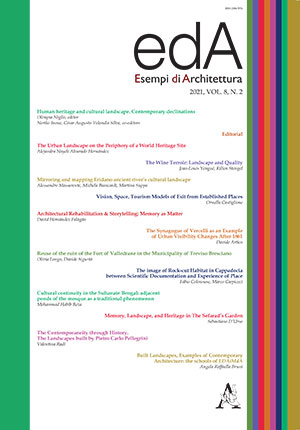Estratto da
ESEMPI DI ARCHITETTURA
International Journal of Architecture and Engineering
MEMORY, LANDSCAPE, AND HERITAGE IN THE SEFARAD’S GARDEN
ESEMPI DI ARCHITETTURA
International Journal of Architecture and Engineering
MEMORY, LANDSCAPE, AND HERITAGE IN THE SEFARAD’S GARDEN

The proposed considerations aim at showing that there is no landscapes nor heritage without memory. The role memory plays in the age of liquid modernity, of digital control and big data, is still critical in order to define both the human sphere and the cultural domain. Landscapes and heritage as cultural facts depend precisely on memory. It can likewise be said that, as supported by science, that man is memory. Further, memory, in terms of locus of relations over time and transformation of space, is narration and, together with oblivion, “constructs” knowledge. Landscapes and heritage are the outcome of this relations-based knowledge. A relational reading of memory is here used as an approach to a project which sheds light on the subject of the stratification of landscapes and the resurfacing of heritage: The Garden of Sefarad in Avila which was created after the accidental discovery of an ancient and forgotten Jewish cemetery buried under meters of dirt. A sort of re- emergence from time, an event that the quantum game of probabilities only could make its manifestation possible. What has re-emerged is a heritage that is at the same time both cultural and human which the project has transformed into a landscape of memory and time-space relations. Heritage and landscapes, if interpreted in light of their mnemonic relations, can be seen as the object of a continuous transformation, namely, as a function of novel relations that observers of that given reality can establish with it. The quantum description of reality means that both the observer and the observed object establish mutual relations, and neither can exist without the other. However, this does not take place if or when memory decides to forget. Hence the importance of memory in defining landscape and heritage.Keywords: Relations, Quantum description, Cemetery.
| pagine: | 237-243 |
| DOI: | 10.4399/978882553987511 |
| data pubblicazione: | Dicembre 2020 |
| editore: | Aracne |








